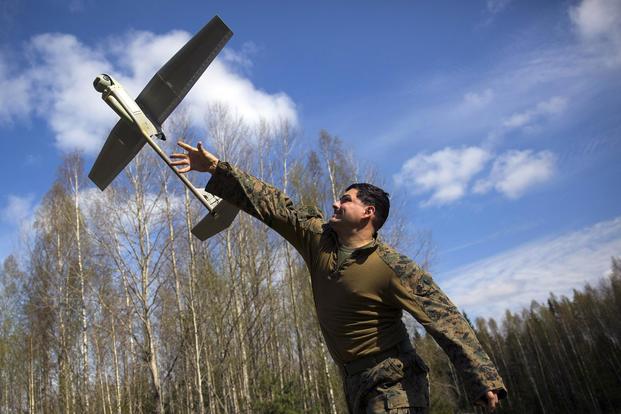The hand-launched small drones used by small-unit commanders for frontline surveillance are now available with upgrades offering better cameras, and they're easier to throw, according to manufacturer AeroVironment Inc.
The improvements available on AeroVironment’s new Puma 3 AE model include new camera technology on a gimbaled sensor payload to allow for better imagery, Errol Farr, director of business development for AeroVironment, said Monday at the annual Sea-Air-Space exposition in National Harbor, Maryland.
"It can get … troops further away from the bad guys and still give them clarity" with higher-resolution imagery from the unmanned aircraft system, he said.
Farr said the new system has seven times better resolution, adding that the initial heave to launch it will be easier with an improved battery.
AeroVironment, whose promotional material says it is the "largest supplier of small, unmanned aircraft systems (UAS) to the Pentagon," announced in March 2018 that it was beginning to take orders for improvements that had been incorporated on its Puma 3 AE small UAS model.
At an Association of the U.S. Army event at the time, David Sharpin, vice president of AeroVironment's Tactical UAS business, said in a company news release that upgrades to the airframe would allow for "operation in even more rugged environments than before."
He also said new software would give greater "reliability in challenging electronic warfare/cyber environments where interference is prevalent."
The Army has been seeking enhancements to make its small UAS fleet more "rucksack-portable." Farr said AeroVironment has made improvements along those lines.
He said the new "grab and go" features include reducing the number of transport cases for the UAS systems from six to four, and a flyable configuration in a single transport case with luggage-type handles.
According to Farr, the military use model, which can operate autonomously or with command control, has a wingspan of 4.5 feet, weighs 4.2 pounds and features a flight time of 60-90 minutes and a top speed of about 50 mph.
Editor's note: This story has been updated to correct the name of the drone.
-- Richard Sisk can be reached at Richard.Sisk@Military.com.














